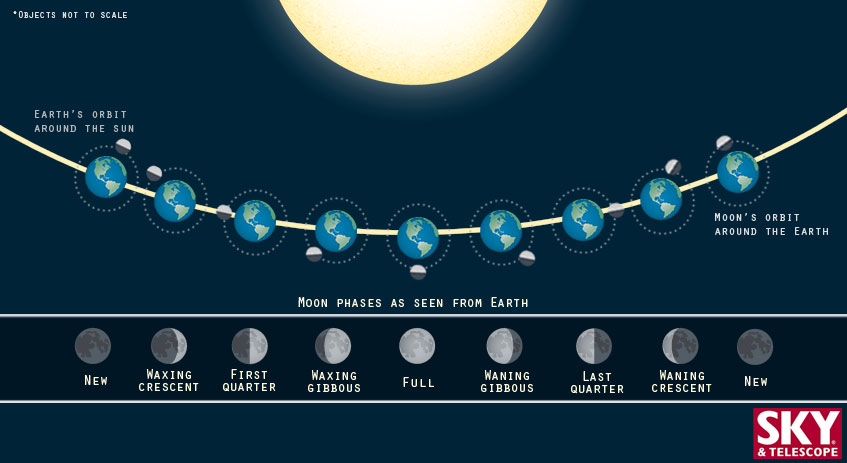Moon phases are determined by the relative positions of the Moon, Earth, and Sun.

S&T: Ana Aceves
Before we describe the phases of the Moon, let's describe what they're not. Some people mistakenly believe the phases come from Earth's shadow cast on the Moon. Others think that the Moon changes shape due to clouds. These are common misconceptions, but they're not true. Instead, the Moon's phase depends only on its position relative to Earth and the Sun.
Find tonight's Moon phase with our Interactive Phases of the Moon Tool!
The Moon doesn't make its own light, it just reflects the Sun's light as all the planets do. The Sun always illuminates one half of the Moon. Since the Moon is tidally locked, we always see the same side from Earth, but there's no permanent "dark side of the Moon." The Sun lights up different sides of the Moon as it orbits around Earth – it's the fraction of the Moon from which we see reflected sunlight that determines the lunar phase.
Moon Phases
The new Moon occurs when the Moon, Earth, and Sun all lie along approximately the same line. Since the Sun is behind the Moon from Earth's perspective, the side of the Moon that faces Earth is dark.
At full Moon, the three bodies also lie approximately in a line, but this time, the Moon is on the opposite side of Earth, so the Sun illuminates the whole side facing us.
At first quarter and last quarter, the Moon lies perpendicular to a line between Earth and the Sun. We see exactly half of the Moon illuminated by the Sun — the other half lies in shadow. The "quarter" used to name these phases refers to the respective fraction of an orbit that the Moon has completed since new Moon.
The illuminated part of the Moon gradually transitions between these phases. To remember the in-between phases you'll need to understand these terms: crescent, gibbous, waxing, and waning. Crescent refers to phases where the Moon is less than half-illuminated, while gibbous means more than half is illuminated. Waxing means “growing” or expanding in illumination, and waning means “shrinking” or decreasing in illumination.
After new Moon, a slice of reflected sunlight becomes visible as a waxing crescent. The lunar crescent grows until first-quarter Moon. As the sunlit portion of the Moon continues to increase to more than half of the Moon's face, the Moon turns waxing gibbous. Then, after the full Moon the sunlit fraction begins to decrease again (though it still takes up more than half the face of the Moon) to make a waning gibbous and then a third-quarter Moon. The slice of sunlight continues to decrease until the moon is a waning crescent and then a new Moon. The whole cycle (from new Moon to new Moon) takes about 29.5 days.
If you have a hard time remembering which way the moon phases go, just think: “white on right, getting bright!”
The Ping Pong Perspective

The Moon's phases are actually related to orbital motion, and there's a simple and fun observation that shows how they're connected. All you'll need is a Ping-Pong ball to simulate the Moon—actually, any small, white sphere would work. Then head outside about an hour before sunset, or around the time of a first-quarter Moon. Find the Moon in the southern part of the sky, then hold the ball up at arm's length right beside it.
You'll see that the ball shows exactly the same phase as the Moon. The Sun illuminates both the ball and the Moon from the same direction, and you see them as partly sunlit and partly in shadow, their bright and dark portions mimicking each other perfectly. If the weather stays clear, you can repeat this observation on the next several afternoons. Each day the Moon's orbital motion has carried it farther east, and the sunlit portion of its disk has grown larger. If you hold your ball up near the Moon, you'll see that its “phase” has thickened too.
To sneak a preview of the Moon's appearance in the days to come, simply move the ball farther east. And if you move it all the way over so your arm points low in the eastern sky, the side of the ball that's facing you will be almost completely illuminated — nearly a “Full Ball,” so to speak. And, sure enough, a day or two before full Moon, the Moon hangs low in the eastern sky just before sunset and is almost completely illuminated.
Try it out!
To find out what phase the Moon is tonight, try our Moon Phase calculator. Note that the Moon's phase is the same for any location on Earth, but Southern Hemisphere observers will see the Moon “upside down” from the Northern Hemisphere view.
Check out this table if you'd like to know an estimate of the moonrise and moonset for each phase. Keep in mind that this is just an approximation meant to guide the casual observer, and there's no correction for daylight (or summer) time. The exact local time depends on a number of factors, including time zone, season, shape of horizon, atmospheric refraction, among other things.
| Phase of the moon | Moonrise | Moonset |
|---|---|---|
| New Moon | 6:00 a.m. | 6:00 p.m. |
| Waxing Crescent | 9:00 a.m. | 9:00 p.m. |
| First Quarter | 12:00 p.m. | 12:00 a.m. |
| Waxing Gibbous | 3:00 p.m. | 3:00 a.m. |
| Full Moon | 6:00 p.m. | 6:00 a.m. |
| Waning Gibbous | 9:00 p.m. | 9:00 a.m. |
| Last Quarter | 12:00 a.m. | 12:00 p.m. |
| Waning Crescent | 3:00 a.m. | 3:00 p.m. |
| New Moon | 6:00 a.m. | 6:00 p.m. |
Take your Moon explorations one step further with the only map you’ll ever need: The Field Map of the Moon.
 0
0









Comments
You must be logged in to post a comment.